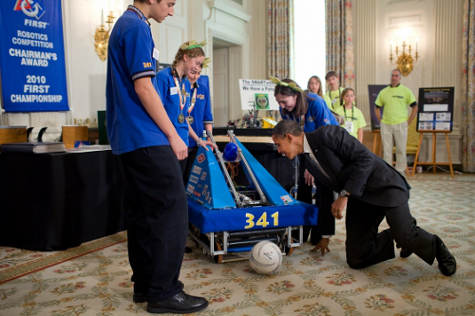Communications of the ACM
Robots, Solar Cars and Rockets at the White House Science Fair

President Barack Obama grabs the steering wheel as Tristan Evarts, of Londonderry, NH, explains how the student invention can detect distracted driving. The President toured STEM competition winners on display in the State Dining Room of the White House.
Credit: Chuck Kennedy / The White House
Middle school and high school students from across the United States descended on the State Dining Room at the White House Monday (Oct. 18) with their award-winning science fair projects in tow. From a robot that plays soccer to a smart toilet that conserves water and an innovative approach to treating cancer, these student projects represent most cutting edge science, technology and engineering.
The White House Science Fair is part of President Obama's Educate to Innovate program move American students from the middle to the top of the pack in science and math achievement over the next decade. The President has made STEM education a priority for his Administration—recognizing that that a strong foundation in science, technology, engineering and math is key for laying the foundation for our future prosperity.
View a video of President Obama speaking about the importance of STEM education to science fair winners from across the country.
Before making remarks in the East Room, President Obama took a minute to check out the projects at the Science Fair and congratulate the students on their impressive achievements. The President also stressed the importance of inspiring students to excel in STEM subjects:
The importance of tapping this potential is why we're here. It's why I wanted to host this fair, which culminates this weekend in a science and engineering festival on the National Mall and across the country where more than a million people are expected to participate.
So we welcome championship sports teams to the White House to celebrate their victories. I've had the Lakers here. I've had the Saints here, the Crimson Tide. I thought we ought to do the same thing for the winners of science fair and robotic contests, and math competitions. (Applause.) Because often we don't give these victories the attention that they deserve. And when you win first place at a science fair, nobody is rushing the field or dumping Gatorade over your head. (Laughter.) But in many ways, our future depends on what happens in those contests—what happens when a young person is engaged in conducting an experiment, or writing a piece of software, or solving a hard math problem, or designing a new gadget.
It's in these pursuits that talents are discovered and passions are lit, and the future scientists, engineers, inventors, entrepreneurs are born. That's what's going to help ensure that we succeed in the next century, that we're leading the world in developing the technologies, businesses and industries of the future.
 President Barack Obama gets down on his hands and knees as he looks at the innerworkings of a robot that plays soccer, built by a team from Blue Bell, PA.Credit: Pete Souza / The White House President Barack Obama gets down on his hands and knees as he looks at the innerworkings of a robot that plays soccer, built by a team from Blue Bell, PA.Credit: Pete Souza / The White House |
The President reflected on the importance of science and innovation in the course of American history:
We can think of Einstein, Edison, Franklin, Tesla, and the founders of Google and Apple and Microsoft. But now we've got some other people to think about—like Mikayla Nelson, who's here today. Where's Mikayla? Is she here? There she is, right there. (Applause.) Mikayla—I had a chance to—Mikayla is from Billings, Montana. She works with an entire team—I'm sorry to embarrass you here, Mikayla. (Laughter.) She's like, "Oh, God, he called on me." (Laughter.)
She's representing Will James Middle School. She and her classmates built a solar-powered car that won the design award in the National Science Bowl. She's in 9th grade. She's already trying to earn a pilot's license, and she's working on building an actual plane. She wants to be an engineer. There's no doubt we can expect great things from her.
We can think of Diego Vazquez and Antonio Hernandez, representing Cesar Chavez High School in Phoenix. Where are those guys? I met them earlier. There they are, right there. (Applause.) They developed a new motorized chair to help a classmate with disabilities—and won a grant competition as a result. They did not have a lot of money to do this. They didn't have a lot of advantages in life. In fact, the first time they were ever on an airplane was when they flew to present their invention. But they did have a desire to work together to help a friend and to build something that never existed before.
And by the way, the way they funded their project—they had—they and their folks made tamales. They had a huge tamale-making session and were selling them. And they were showing me the video of how they raised the funds to be able to enter in this competition. Unbelievable.
That's not just the power of science. That's the promise of America. Anybody with a good idea can prosper. Anybody with talent can succeed. That's why we're here today. That's what we're all celebrating. And that's why it's so important that we promote math education and science education, on behalf of not just this generation but all the generations to follow.
No entries found